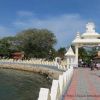නාගදීප විහාරය
Nainativ is one of the smallest inhabited islands in the Gulf of Mannar and is only about 35 miles from India. Merchants have long come here and the surrounding islands to buy the conch shells that are harvested in the warm shallow waters in the Gulf.
The conch shell is of course essential for certain Hindu and Buddhist rituals and a particularly perfect specimen of one spiralling to the right can fetch an enormous price. Pilgrims have also been coming to Nainativ since about the 1st century CE to worship at its famous stupa. In the Mahawamsa the island is one of the sixteen sacred places and the Tamil Buddhist epic, Manimekalai, mentions a gem studded throne and a stone with the Buddha’s footprints at Nagadvipa which pilgrims from India used to come and worship. The heroine of the epic is described as wandering amongst the island’s 'long sandy dunes and lagoons’.
As the boat approaches the main jetty the pilgrim will see the distinctive red and white-striped walls of the Hindu temple. Although there has been a temple here for many centuries the present one is not old and is of no particular interest. However on either side of the side entrance to the temple there are two very ancient objects. On the left as you enter is a large stone with an inscription of Parakramabahu I on it. In the first part of this inscription the king says that foreigners coming into the country should enter only at Uraturai (Kayts) and that they should be helped if in need. This undoubtedly refers to merchants and pilgrims from India. The second part says what measures should be taken if ships carrying elephants or horses and merchant ships are wrecked. On the right of the entrance is a large life saver-shaped stone, an ancient anchor. Arab ships used to carry such anchors.
Less than half a kilometre down the road from the temple is Nagadvipa Vihara marking the place where the Buddha is supposed to have stayed during his visit to the small island. On one side of the road is the Bodhi Tree and on the other is the silver painted stupa. There are two temples as well, one containing a bronze Buddha image donated by the Burmese government in 1956. Nothing at Nagadvipa is of any aesthetic or historical interest, everything having been built in the 1950’s.
HOW TO GET THERE
Half the enjoyment of a pilgrimage to Nagadeepa is actually getting there. The road from Jaffna runs across a long causeway to the island of Kayts from where another causeway leads to Punkudutivu. The landscape is flat and sandy, dotted with numerous palm trees and completely different from everywhere else in Sri Lanka. On the far side of this second island one must take a boat to Nainativ where there are two jetties, one at the Hindu temple and another at Nagadeepa Vihara. If most of the passengers are Hindus the boat stops at the former and if most are Buddhists it stops at the latter. Public and private buses run regularly from Jaffna to Punkudutivu and the boat is timed to leave just af







